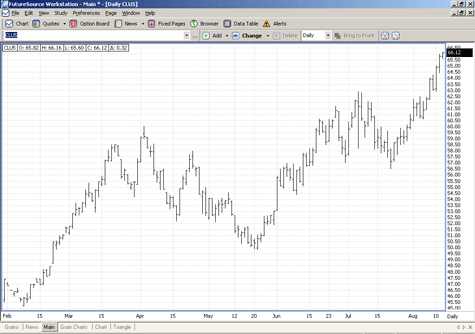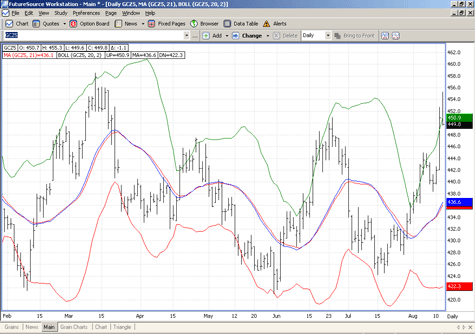The futures markets are exciting and attractive to many individuals. However, potential traders are faced with the daunting task of determining how they should make their trading decisions. Potential traders need to develop a trading method that fits their personality, risk tolerance, time horizon, and time commitment objectives. We will discuss several trading styles and methods that will help the trader develop a method that best suits his or her needs.
Time Frame
Time frame may be the most significant aspect to consider when determining your trading method. Someone who is a big-picture person and looks at markets in macro terms would not be suited to day trading. A long-term trend-following system would be a method a macro-type trade would consider. To trade with a long-term perspective is not suited for everyone. It requires a great deal of patience and perseverance to hold a position for an extended period. If a market trends higher over a 20-day period, it would be extremely rare that it would move higher everyday without closing lower on any given day. It is very difficult for a person without a great deal of patience to sit through a few days or even a week of lower closes. In a trade the eventual moves higher in the macro view, you may end up sitting through days if not weeks of a losing position. For this reason, the long term, macro approach is usually employed by large funds and institutions.
Many futures traders like to exit all their positions by the end of the day. These traders are more comfortable trading in terms of minutes and hours as opposed to days and weeks. A day trading strategy has many appealing features, such as lower capital requirements and no overnight market risk. The biggest draw back to day trading is the time requirement. A day trader must be in front of a computer as long as they are involved in a trade. It is the time requirement that makes day trading an unrealistic option for many potential traders.
Futures traders looking for something between day trading and long term trading usually fit into what is often referred to as swing trading. The traditional view of swing trading is quick 1-5 day trade taking advantage of a shorter-term move. This medium term time frame is popular as most traders place all their orders before the market opens and do not have to monitor their positions all day.
Risk
Risk usually correlates well with reward – usually, the bigger the risk, the bigger the potential reward. Day traders normally risk less on an individual trade and are looking for a smaller profit. They often will make many lower-risk trades in search of numerous small rewards. Long-term traders are willing to risk more per trade in search of the larger profit that a big market move can bring.
A fine example of this would be the crude oil market. Crude oil is in the news every day as we see a market that has moved above $65 per barrel. A long-term macro trader may have bought crude oil futures a few months back at $45. The crude market went from $45 to $60, and back under $50 before eventually rallying to new all-time highs of $66. Many macro trades have had $70 crude in mind since this move started. A trader unwilling or unable to withstand $5,000 per contract swings in equity would not have been able to hold on to their position.
Any trades are educational examples only. They do not include commissions and fees.

In contrast to the above example, a day trader buying an e-mini S&P contract places a 3-point stop looking for a 5-point move higher. The trader is right and as the trade moves higher they quickly tighten the stop order. This trader intends to initially risk $150 to make a $250 profit all before the close of the trading day. Unlike the macro trader, a day trader is not looking for a longer-term 50 or 100-point move in the index over a 1- 6-month period.
Personality
The trader is the only one who can truly determine what best fits their personality. A person who does not have the time or the desire to sit in front of a computer will not do well as a day trader. A person who is not comfortable with taking large financial risks and looking for even larger rewards would not do well as a long-term trader.
Usually, traders do not have the disposition to sit with long-term futures positions, especially when they are going the wrong way. Part of the problem may be the fact that many traders sit in front of a quote screen all day. Sitting in front of a quote screen and watching the markets tick-by-tick makes it difficult to see the forest through the trees. For that reason, traders may be suited to either day or swing trade. Day trading does not allow traders to attend to any other business during market hours so it is not a practical alternative. With a shorter-term, swing trading, type system, you can place your orders in the morning, determine your entry and exit points after the close, and have market hours free.
Developing a Futures Trading Strategy
In looking for a futures trading methodology, write down the time frame preference as well as market beliefs you hold. For example: a trend-following method, with a swing trading time frame, that uses shorter-term breakouts as an entry. A trader may look at a reversal system that uses a combination of bollinger bands and key reversals for entry setups. No one method suits all traders. For any method to work, a trader has to stick with it. A method that does not fit the trader’s personality will be difficult to follow.
A Theoretical Futures Trading System
Trader A is a busy professional who is comfortable with trades lasting anywhere from several days to several weeks. He is very comfortable staying in a trade longer if it is making money but does not like to stick around in losing trades. The trader likes to trade in the direction of the trend and likes to use breakouts for entry points.
Trader A’s system uses the following parameters:
- 21 day moving average
- 5 day new high or low to determine entry
- The system will enter a long trade if the market makes a new five bar high above the above the 21 day moving average and has traded above the average at least one of the past five days.
- The trader will exit the position on a new five bar low. If the new five bar low is below the 21-day moving average and the market has traded below that average at one of the last five days, reverse the position.

Any trades are educational examples only. They do not include commissions and fees.
The above example would be a basic futures trading strategy that the trader could back-test on numerous markets to determine how it would have performed in the past. If the basic ideas behind the method are sound, the strategy may work in the future. The ideas of buying strength and selling weakness have been around the markets for a long time. Trading the long side above a moving average and trading from the short side below a moving average are also well-established trading ideas.
The trader would also need to select markets to follow with this system. The trader would need to determine the amount of risk capital they have available and work backward. Unless a trader can afford to trade a basket of 30-plus contracts, they should look to select non-correlated markets with quantities determined by margin. For example, a system that traded 1 contract of oats and 1 contract of crude oil would be far heavier weighted in the crude oil. To balance this, the trader would trade a quantity of oats that matched the margin for the single oil contract. As a rule of thumb, this works well for balancing a portfolio of futures. The margin requirement is determined by the volatility of the contract.
The above system has not been back-tested and it is not recommended anyone trade it without first doing so. Intuitively, this system is probably a good start for developing a methodology. The basics behind the system make sense although the time frames may need to be adjusted.
Developing a futures trading strategy can be a very rewarding endeavor as it forces you to think about your personality as well as your market beliefs. Developing a futures trading methodology will force you to have a reason for trading and makes it difficult to justify trades made on gut instinct and feel.
